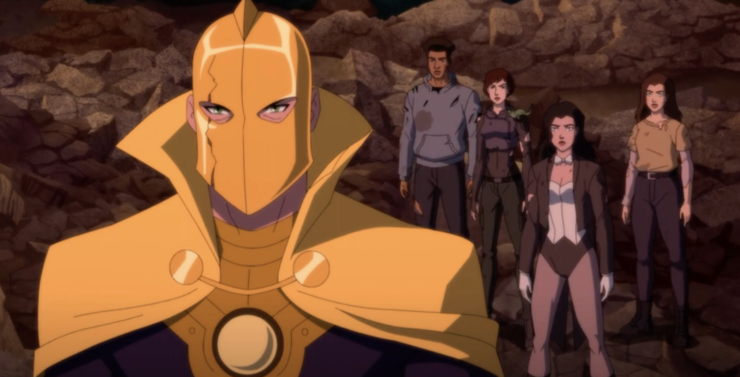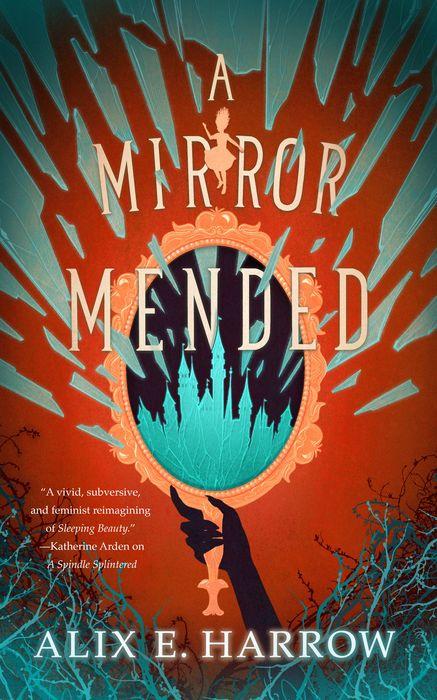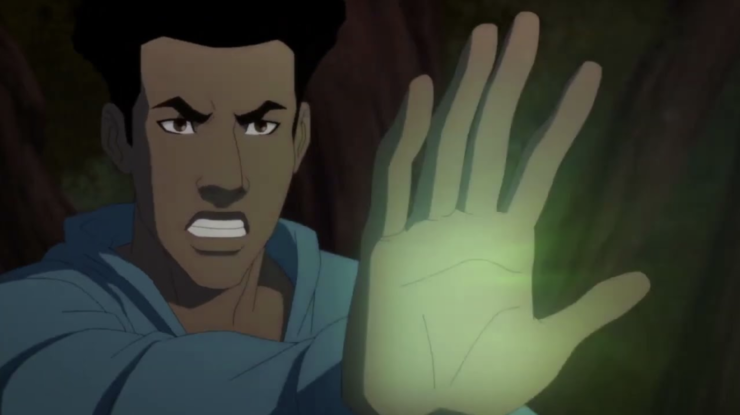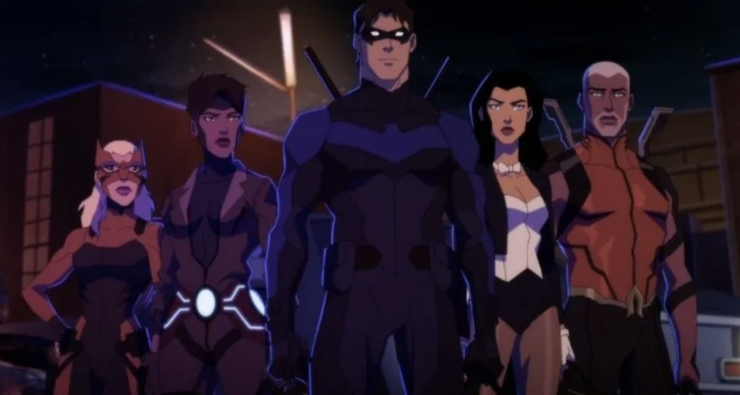The DC animated show Young Justice has a problem: its heroes aren’t exactly young anymore.
What started out as a series about the adolescent sidekicks of mainstream Justice Leaguers like Batman and Martian Manhunter has become, as some fans put it, the generic DC show, stuffed with heroes and villains of all ages.
Showrunners Brandon Vietti and Greg Weisman abandoned the tight focus on a core group of teen heroes from season two, opting instead to include more adult heroes, though the drama still centered around the original crew. Season three took things even further, as the adult Justice Leaguers became involved in a cold war between the heroes of Earth and Darkseid.
Season four (also called Young Justice: Phantoms), which finished airing in early June, has been an attempt to restore the show’s original focus.
[Major spoilers for season 4]
The twenty-six episodes are split into six intersecting mini-arcs, each following a member or two of the original squad: Superboy, Miss Martian, Tigress, Zatanna, Aquaman, Rocket, and Nightwing. B-stories often follow some of the younger heroes the show introduced to keep the teen vibe going, like Beast Boy and Halo.
And it…kinda works? When the writing is tight, we get some character moments for our main characters that feel well-earned, like (spoilers!) everyone’s grief at Superboy’s apparent death. But having so many characters in the mix forces tradeoffs. In the latter half of the season, the emphasis shifts more towards the younger heroes, and the main characters who’re supposed to lead the arcs (Aquaman, Rocket, and Nightwing) are all given short shrift. Dick Grayson doesn’t even get a proper arc because his episodes line up with the end-of-season climax: The only memorable character beat is one tantalizing moment of sexual tension with Zatanna—when he’s shirtless and she’s very interested—before it’s time for everyone to suit up and save the universe.
Essentially, the showrunners seem torn between continuing the show’s natural progression into a more mature, adult series, and telling the stories of teenagers navigating their dual identities as people and superheroes. Season four makes it clear that the original squad aren’t kids anymore. They’re adults leading very adult lives. Superboy and Miss Martian are engaged; Tigress is done with school and working as a professor; Zatanna is training the next generation of magic superheroes; and Rocket even has a son!
There’s so much potential in these stories. When Young Justice first came out in 2011, I was roughly the same age as the characters. We were going through the same fumbling first romances and frustrations with the world of adults. Now we’re both in the trenches of early adulthood, making similar life decisions about when to settle down and what matters in the long run.

When Young Justice commits to this change, it works. Decisions are morally ambiguous, character interactions grittier. It’s fascinating to watch familiar characters go through new challenges. We see Zatanna manipulate her teen mentees into sharing the role of Doctor Fate with her, so that her father can finally be free of that burden. And when she’s called out on it, she doesn’t offer a convincing defense of her actions. We see Tigress reconnect with her sister, the redeemed villain Cheshire, after years of trying. But when Cheshire decides she isn’t ready to be a mother to her daughter again, Tigress has a hard time swallowing it. Eventually, she has to accept that Cheshire is a different person, with needs different from her own.
Clearly, no one’s got simple teen angst in this show anymore, so that baton gets passed to the younger crew.
And of course, the new batch of younger characters are interesting too! For instance, Beast Boy is given a grounded, very rewarding arc about mental health and trauma. He’s thrown into depression after Superboy’s ‘death’ and there’s no easy way out. He pushes everyone away and refuses to get help—and he knows he needs help too. It’s a very realistic portrayal of how mental illness causes endless self-recrimination. It takes a while before Black Canary is able to get him to forgive himself using her signature therapist’s compassion, and even then Beast Boy doesn’t immediately bounce back. He gets a support dog and intentionally takes leave from superheroing to heal. His friends welcome him back, though his ex doesn’t—she’s happy for him, but she’s moved on. The season ends with Beast Boy facing an uncertain future, but finally secure in his own self-worth.
Buy the Book


A Mirror Mended
This is Young Justice at its best, trying to push the show into a more socially-conscious age. But that magic is missing from the main characters’ arcs in the second half of the season. Aquaman is supposed to be dealing with the same struggle as Beast Boy. He knows he’s burnt out, but taking a break would leave Atlantis undefended. Unfortunately, his arc is too much monster-punching and not enough introspection, and next to Beast Boy’s it feels uneven and forced. Meanwhile, Rocket is supposed to be figuring out a work-life balance and learning to accept her son’s autism. But her whole arc takes place off-world on New Genesis, so we barely get to see what her family life is like.
Another strength of this season is the show’s approach to representation. In Aquaman’s arc, we see not one but two relationships involving bi men—Aquaman’s and Lagoon Boy’s, which also happens to be a polygamous marriage. (The scene of him embracing his husband and wife after their child is born is just adorable.)
The absolute standout for me was the representation of Muslim characters. Again, the show avoids tokenism and portrays identities in a thoughtful, complex way by giving us multiple characters to identify with. There’s Halo, a Mother Box from New Genesis inhabiting a human body, and Khalid Nassour, an Egyptian-American medical student being mentored by Zatanna.
Khalid is a man conflicted: he’s the child of an immigrant father who insists he become a doctor, but is also a sorcerer who wants to save lives in another way. His epiphany comes during a powerful dream sequence where he starts to drown, quite literally, under all his parents’ expectations, before he rises above the water while a lilting adhān (the Islamic call to prayer) plays in the background.

“I can and will be both a doctor and a sorcerer,” he says. “That is my jihad, my inner struggle. In my world, magic is a science of its own, another tool from our Creator to serve what’s good.”
As an immigrant Muslim kid myself, I love this representation. It’s nuanced—and yes, it’s preachy, but when there’s so few good Muslim characters on American TV, that’s easily forgiven.
Besides, there’s also Halo’s subtler arc. They’re still figuring out what it means to be human. This season, that journey takes them through a series of realizations. They begin to identify as non-binary and use they/them pronouns while maintaining the hijab, although admittedly they’re still figuring out what draws them to it. You couldn’t ask for greater realism—as their mother explains to them, people wear the hijab for many reasons, not all of which can be easily parsed and articulated to others.
In the end, Young Justice: Phantoms is spread awkwardly around two different groups of characters and themes. If the show is renewed by HBO Max for a fifth season, it’s unlikely this arc model can continue, because the Earth vs. Darkseid showdown is looming and that’s going to require everyone to be involved. Which means that the showrunners better choose between the two options the fourth season sets out: Do you stick with the older, mature crew, or follow the younger teens who are still figuring themselves out? Only time will tell.
Tahmeed is a writer, journalist, and editor based in Toronto. His fiction has been published in Lightspeed magazine. Find him on Twitter @tryingtotype. He thinks cities are most beautiful in the rain.











This review is basically my thoughts on the entirety of the season and the series in general. They need to pick what they want to focus on and stick to it. I’m glad characters like Rocket and Zatanna have gotten spotlight but this show needs to choose what it wants to be. They don’t have enough time to do everything they want to do and instead of adapting to that, they are doing too much with too little time. I like the world building but it takes up too much space. They need to focus on a specific set of characters and stick to them in my opinion.
I actually liked this season’s grand tour of the DC universe approach. Maybe not for every season, but the kitchen sink approach helped give the kind of scope I’ve always liked DC for when they’re not rebooting themselves out of coherence. And I felt like the different locales and groups were sketched in impressively well given the limited time we had with each.
I don’t have a problem with the maturation of the core cast; one of the greatest charms of YJ’s Earth-16 is the distinct lack of “comic book time”. Don’t forget, this is the show that had a five-year time jump between the first and second seasons. “Little Orphan Annie Syndrome” was never part of Greg Weisman’s game plan.
I found no particular lack of youthful characters in this season; Garfield Logan is 18 at most, and he had at least 1/3 of the first story-line, which further set up a well-realized season-long character arc. Tigress’ arc gave focus on the previously undeveloped Caasandra/Orphan, and introduced Onyx. Zatanna’s segments gave us no less than three younger heroes in the Sentinels of Magic, two of them new to the show. The Atlantian arc, (which focused more on world-building), had an introduction to the next generation of Aquamen in the form of Young Prince Artur. Raquel/Rocket’s story, admittedly lacks such a focus, but did give her more character development than she got in the three previous seasons. And the concluding episodes introduced 11 & 1/2 year old Danny Chase to the mix, and if that’s not young enough for you, then I’ve got nothing.